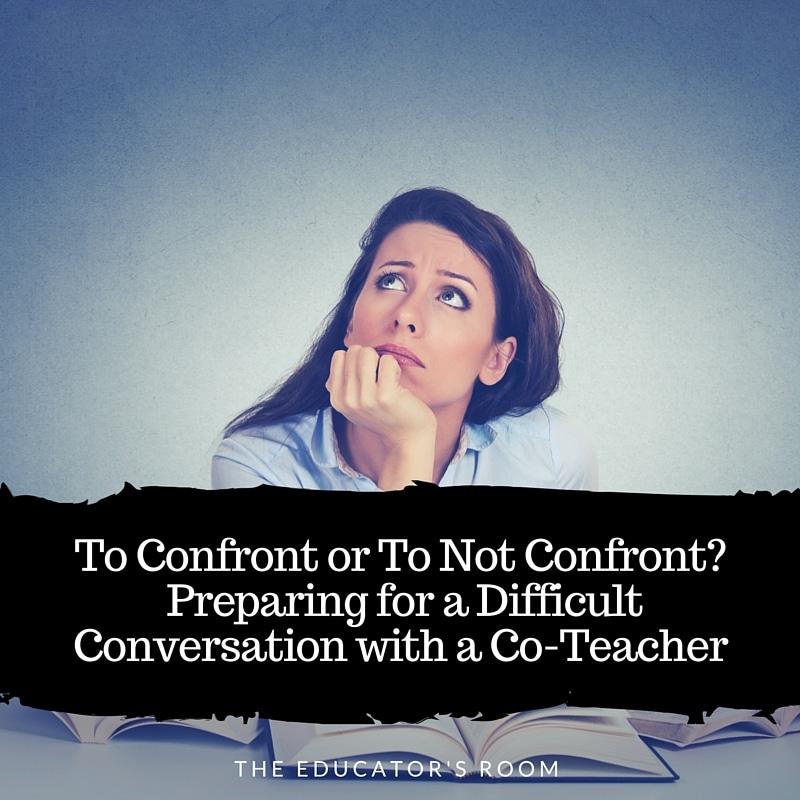“That’s not what we usually do.” “Well, if it was me, I’d…” “In so-and-so’s class, we’re…” “I think of it this way…” “You’re a young teacher…” Some of these conversation starters can lead to effective dialogues and lesson enhancements. However, when your co-teacher is saying these things out loud during class in front of twenty students, the words only create walls of resentment.
Within five years of teaching, I have taught a Class-Within-a-Class (CWC) three times, and each relationship with my co-teacher has looked different. During one of those classes, I was constantly hearing the above words, which made me feel insufficient. Initially, the off-handed criticism was rarely spoken, so I ignored it. However, by the second quarter, my co-teacher said these phrases on a daily basis. At that point, I realized the effect on my students: confusion. Since I was a relatively new teacher to the profession and the district, I still needed to prove myself, and the students started to doubt my expertise. And then it trickled into other areas. My co-teacher criticized my practices in other classes, including ones she had never taught, and the clubs I sponsored. Eventually, I reached my breaking point. It was time to act.
I hate confrontation. I’m the type of person who explores all other options, and more often than not, I attempt to talk myself out of action (“You’re being too sensitive” or “It’s not that big of a deal”). Mostly, I’m fearful of the fallout, and since I had to continue to work with this teacher for the rest of the year, I was very conscious of the process. Here are the steps I used for a successful difficult conversation.
[fusion_builder_container hundred_percent=”yes” overflow=”visible”][fusion_builder_row][fusion_builder_column type=”1_1″ background_position=”left top” background_color=”” border_size=”” border_color=”” border_style=”solid” spacing=”yes” background_image=”” background_repeat=”no-repeat” padding=”” margin_top=”0px” margin_bottom=”0px” class=”” id=”” animation_type=”” animation_speed=”0.3″ animation_direction=”left” hide_on_mobile=”no” center_content=”no” min_height=”none”][bctt tweet=”I’m fearful of the fallout” username=”EducatorsRoom”]
Create Talking Points: Writing helps me sort through my thoughts, so I journaled about my concerns and feelings regarding my CWC dynamics. After sifting through the emotions, I pinpointed the main problem: control. Based on our interactions, I felt threatened by her attempts to control my classroom. Part of the problem is that my administrators have never trained the staff on effective CWC partnerships; they have left it up to the teachers to “figure it out.” My past CWC co-teacher relationships (at other schools) had been organized differently: the Special Education teacher sat in the back of the room, took notes, walked around during work time, and kept me informed about accommodations. Basically, they were teacher assistants. That was my understanding of CWC, but according to textbooks, that is not effective. No one told me that. By completing this step, I realized the progression of the problem and my own faults. This humility calmed my raging emotions and opened my mind. As best as possible, don’t create a laundry list of talking points; stick to a select few (or better yet, an umbrella idea). No one likes to be on the receiving end of a mile long “this is why you’re a bad co-worker” list.
Ask for Help: Once I had decided that confrontation was needed, I spoke to my department chair. Be careful with this step- this is not an opportunity to recruit forces. I approached my DC for advice and awareness. I listed the facts (avoid the emotional narrative) and explained why I felt the need to address the issue. My DC provided information about the teacher’s working history, which led to new insights about how to approach my co-teacher. Additionally, my DC encouraged me to speak to the other CWC teachers who worked with this SPED teacher in order to gain a better understanding of effective CWC strategies. When I talked to the other teachers, I didn’t recount the soap opera. I simply said that I was curious about CWC strategies. During this investigation, I realized that there was a wide spectrum of expectations for this SPED teacher: one teacher seamlessly taught with her (if a stranger walked in, he wouldn’t know who was the lead teacher), one teacher allowed her to plan mini-lessons and short activities, and another teacher treated her like an assistant (only expected her to help during student collaboration and independent work time). Since I had never set my own expectations with the SPED teacher, it was not surprising that she didn’t understand her role in my classroom.
Establish Boundaries and Find a Compromise: Come into the conversation with a plan, but be prepared to alter your plan. Prior to the meeting, I wrote down how I pictured our class dynamics. I acknowledged my comfort levels and areas of growth. For example, the comments about age and inexperience needed to completely stop. Repeating the fact would not make me a better teacher. Comments about other teachers’ practices were for private conversations. As for areas of growth, I decided to suggest that we plan lessons together and discuss her leading a unit second semester. These actions addressed the major issue of control.
Right Place and Time: Respectfully, I carefully selected the setting of the conversation: library after school. Considering our dominant issue regarded power, I didn’t want the location to give anyone the upper hand. We both had equal rights to the library, and we could ensure privacy while still being in public. Difficult conversations should never be held before school, so I asked the teacher to talk to me after school. Additionally, I asked my DC to be nearby just in case we needed mediation. Be intentional with the setting because it sets the tone of the conversation.
Although initiating the conversation was stressful, the conversation went smoothly. My co-teacher and I needed to reset and refocus, and we were able to do that by laying our concerns on the table. During the second semester we resembled a team. Sure, we had ups and downs, but I grew as a professional. Letting go of control and trusting her prepped me for future activities with my students. Difficult conversations with coworkers can tear apart a team, but they are necessary to be successful. By preparing for the conversation and not confronting her in the heat of the moment, I ensured our working relationship.
 [/fusion_builder_column][/fusion_builder_row][/fusion_builder_container]
[/fusion_builder_column][/fusion_builder_row][/fusion_builder_container]






